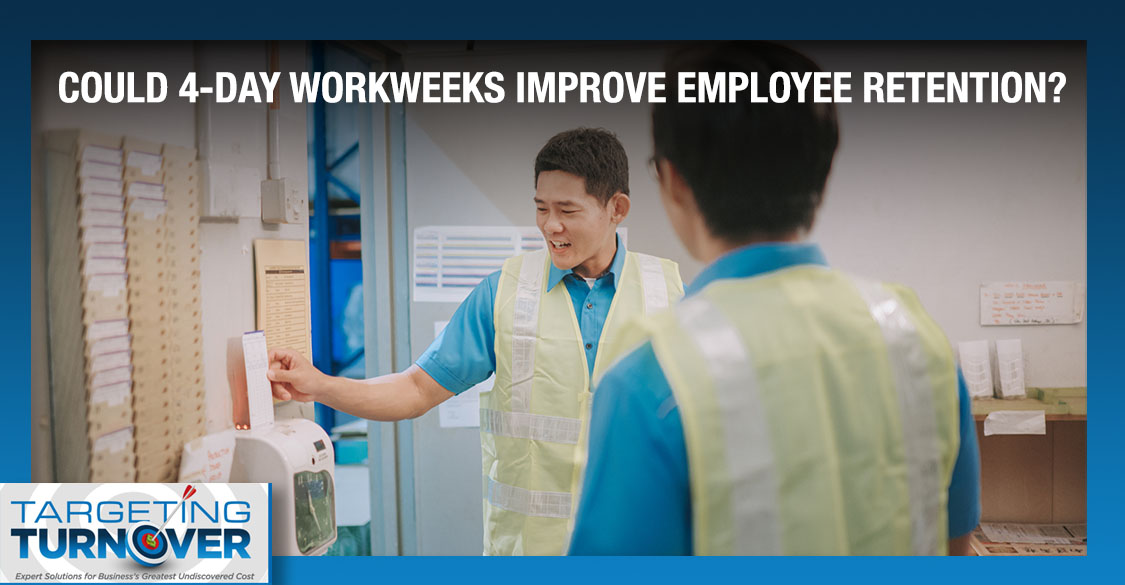Data shows a four-day workweek is popular with employees. On the company side, data suggests work satisfaction and productivity are up, recruiting is easier…and employee turnover is down. And during these days workforce shortages, every company is seeking a recruiting edge. Could this be “it”?
Why Stay Interviews Q2 is “What Are You Learning Here?”

Most readers know that when I invented Stay Interviews that they came packaged with just 5 questions…and Q2 as we call it is “What are you learning here?”, followed by “And what do you want to learn?”
Stay Interviews Q2 is an Easy Way to Open the Trust Portal
Q2 is the low-hanging-fruit way for supervisors to identify how they can add one additional brick to the foundation of building trust with each member of their teams. We teach managers the simplicity of the Q2 process:
- Ask Q2.
- Listen to the response.
- Take notes.
- Probe to learn more.
- Then identify something your employee wants to learn.
- And build a plan for them to learn it.
Sometimes the employee might say “I don’t want to learn anything new, I just want to work and go home”, which is very OK. Or another might say, “I want to keep learning but I can’t think of anything specific right now”, to which we teach managers to suggest they meet again in a few days and each brings a short list.
The solutions to a learning request can bridge from arranging a series of one-on-one training sessions with an onsite subject expert to for another example the manager might recommend an internal or external class…or even suggesting a specific YouTube video. Learning opportunities are all around us, enhanced by the internet, such that anyone who wants to learn has no excuses for not finding a way.
—–
Further reading: The Original SI5 and Why they Still Matter
—–
Stay Interviews Q2 Proves Learning Is Easy, Career Development Is Not
Ponder for a moment on the continual appearance of “career development” in your engagement survey results, HR strategic plans, and throughout discussions regarding how to improve retention and engagement. Then consider the following two questions to measure how important is structured, step-by-step career development versus searching out customized opportunities to learn for each of our employees:
- For what percentage of your current employees do you actually have a career? What percent of nurses, manufacturing floor workers, call center agents and others do you see yourself having a job to promote them to plus their becoming qualified to earn that role? I’m guessing your answer ranges between 10% and 30%…keeping in mind you must first have an opportunity to advance them.
- Again considering your current employees, what percentage of them are ambitiously aiming themselves for another job with your company? Healthcare companies often talk of careers for nurses or CNAs, yet I find both groups are mainly interested in less stress much more than they want to secure a different role.
Now consider the time and energy that many companies have invested into “career development”:
- Some companies require that each manger develop a tightly scripted, specific career plan with each member of their teams.
- “Career check-ins” are prescribed quarterly or on some other mandated schedule.
- HR develops “career ladders” that show likely progression trails…for which managers sometimes force-fit employees into the right box in order to fulfill the tops-down mandate that each employee has a career plan.
A recent poll conducted by the U.S. Chamber of Commerce showed 41% of Americans are looking to switch industries for their next job,[i] which tells me they are looking for something new…something that aligns with their natural curiosity that meets their needs for a happier life.
Here’s another way to view the crucial difference. “Career ladders” are close-ended in that they offer a limited number of industry-specific options. “Learning” is open-ended as it permits employees to choose their own unique path.
—–
Further reading: Are You Hiring for a Calling or a Job? It Impacts Retention
—–
Can Stay Interviews Q2 Help You Retain Your Employees Six Months Longer? Maybe.
Below is data regarding low long employees stay by specific generations[ii]:
- Baby boomers stay with one employer an average of 8 years, 3 months.
- Millennials stay an average of 2 years, 9 months.
- Gen Z stays an average of 2 years, 3 months.
A few years ago we would have said that young workers cannot sustain their continual job-hopping, either because employers won’t hire them or they would have developed families, bought homes, and morphed their way into more bills to pay. That wishful thinking, though, is long gone because the excess of jobs compared to our number of workers is such that each qualified worker will have her pick of jobs for the next decade or so.
But as our “wishing for” years went by, young workers became less young. In fact, the oldest millennials turn 41 this year and 51% of all U.S. jobs today are held by either millennials or gen Z. More shocking, millennials will occupy 75% of all U.S. jobs by 2025…and that year begins in just 15 months.
For many of today’s workers, the most optimistic pathway is to retain them for six months longer than you retain them today. And I’m guessing here that the road to retaining each individual employee is to take their cues on what they want to learn rather than instructing them by way of a pre-established career plan. And that’s why our Q2 is “What are you learning here? And what do you want to learn?”
—–
Further reading: For Employee Retention Career Development is Out, Learning is In
—–
Want to keep learning new ideas and ways to improve your retention but not sure where to start or how to convince your executives? Write me DFinnegan@C-SuiteAnalytics.com or connect with me if you want to have a one-on-one conversation on how you can get started on your life-long learning journey to cu turnover.
—–
[i] https://triblive.com/local/valley-news-dispatch/switching-career-fields-is-more-common-than-you-think/
[ii] Career Builder, 2022



